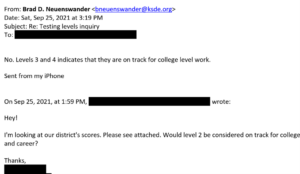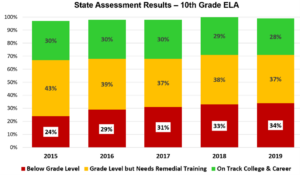The Kansas Department of Education dumbed down achievement standards about 20 years ago under No Child Left Behind, and now they are trying to do it again.
 KSDE introduced the current state assessment test in 2015, measuring outcomes in four levels. Level 1 is below grade level. Level 2 is grade level but not on track for college and career, and Levels 3 and 4 are on track for college and career.
KSDE introduced the current state assessment test in 2015, measuring outcomes in four levels. Level 1 is below grade level. Level 2 is grade level but not on track for college and career, and Levels 3 and 4 are on track for college and career.
The state assessment results were never what most parents would call ‘good’ or ‘acceptable,’ but education officials went out of their way to give parents and legislators a false sense of high achievement. As even the Kansas City Star is now examining flagging achievement levels it seems that parents are coming to realize that they have been deceived. Now KSDE is trying to reduce the standards so that more students qualify as being on track for college and career.
Many candidates running for school board are telling the truth about student achievement. They are telling parents that there are more high school students below grade level than are on track for college and career. That has the entrenched bureaucracy running scared, so KSDE rides to the rescue with lower standards that make school boards and administrators look better.
 As recently as last week, Deputy Commissioner Brad Neuenswander told a parent that Level 2 is not on track for college and career.
As recently as last week, Deputy Commissioner Brad Neuenswander told a parent that Level 2 is not on track for college and career.
On September 25, the parent asked Neuenswander if Level 2 is considered on track for college and career. He replied, “No. Levels 3 and 4 indicates that they are on track for college and career.”
That email is just one piece of evidence that shows KSDE is trying to reduce standards to create a better picture of student achievement and protect the bureaucracy at the expense of students. Others include:
- KSDE has shown no proof that the Board of Education approved any change in standards.
- Their so-called Success Awards handed out this summer used Levels 3 and 4 as the basis for being “academically prepared” for postsecondary success.
- Their January 2018 application to the U.S. Department of Education for approval of the state plan to comply with the Elementary and Secondary Education Act says, “Levels 1 and 2 are categorized as not proficient. Levels 3 and 4 are proficient.”
No evidence that the State Board of Education approved any changes to standards
The State Board of Education approved the standards introduced in 2015, and their approval is required to change standards.
We asked Neuenswander when the board approved changing the standards to include Level 2 in the on-track designation, but no response was provided as of this writing. If the board did approve a change, we certainly want to see it and examine the justification they were given to reduce the ‘on track for college and career’ standards.
Just Levels 3 and 4 are “Academically prepared”
This summer, KSDE gave awards to districts for being academically prepared for postsecondary success. They write, “For Kansas to achieve its vision for education in the area of academic preparation, 75% of all students need to score at or above Levels 3 and 4 on state assessments.”

They show the state average for all students is less than 50%, but even that is misleading because it is the overall average of students in grades 3-8 and 10. Achievement drops precipitously as students move from one grade to the next, and only about 25% of high school students are on track for college and career in English language arts and math.
KSDE says Levels 1 and 2 are not proficient
In January 2018, KSDE submitted a plan to the U.S. Department of Education for compliance with the Elementary and Secondary Act. In the Academic Achievement section on page 25, they say, “Levels 1 and 2 are categorized as not proficient. Levels 3 and 4 are proficient.”
It begs credulity to say students who are not proficient are academically prepared for college and career.
KSDE claims don’t pass muster
KSDE now claims in an email to Kansas Policy Institute (the Sentinel’s parent company) that Level 2 is on track for college and career. Instead of having 28% of high school students on track for college and career, they want to believe that 65% are on track in English language arts (28% in Levels 3 and 4, plus 37% in Level 2).
Here is the rationale provided by Deputy Education Commissioner Brad Neuenswander.
 “A student performing at mid-level 2 on the ELA assessment, according to research performed by KU since the original cut scores were set, meets the ACT college readiness benchmark.”
“A student performing at mid-level 2 on the ELA assessment, according to research performed by KU since the original cut scores were set, meets the ACT college readiness benchmark.”
At the very least, KSDE here admits that not all students in Level 2 are on track for college and career. But even that doesn’t pass muster.
If 65% of high school students were really on track in English language arts in 2019, why did ACT report that only 27% were college-ready in English, Reading, Math, and Science in 2019? But 27% college-ready on the ACT seems relatively close to the state assessment results of students in Levels 3 and 4 – 28% in English language arts and 25% in Math.
The 2020 ACT results showed only 23% of Kansas graduates were college-ready in all four subjects.
Neuenswander also said, “The Kansas assessment no longer measures grade-level performance.” That claim is in direct conflict with the standards approved by the State Board of Education in 2015, shown earlier in their graphic. Levels 2, 3, and 4 were designated as being at grade level, leaving Level 1 as below grade level.
In 2019 at an Overland Park Chamber of Commerce meeting, I said that with 41% of students below grade level in math, school districts all across Kansas and in Johnson County know they are giving diplomas to students who are below grade level. The superintendents of Olathe and Shawnee Mission were in the room, but they didn’t disagree. They sat silently waiting for someone to change the subject.
Conclusion
The state assessment test, ACT, and the National Assessment of Educational Progress all show that student achievement is much lower than parents have been led to believe, and that won’t change without legislative intervention. Legislators have provided more than $5 billion in extra money since 2005 that is supposed to be used to help ‘at risk’ students and close achievement gaps. But a 2019 legislative audit concluded that most of the ‘at risk’ funding they reviewed “was used for teachers and programs for all students and did not appear to specifically address at-risk students as required by state law.”
Legislators are aware of this sad reality, but some fear that taking action will jeopardize their re-election. Doing nothing, however, is effectively saying student achievement is acceptable. And that condemns tens of thousands of students to a lifetime of underachievement.



